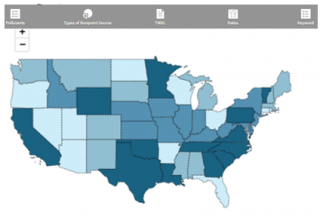Success Stories about Restoring and Protecting Water Bodies Impaired by Nonpoint Source Pollution
On this Page:
Read the Success Stories

This page features stories about primarily nonpoint source pollution-impaired water bodies, where restoration and protection efforts have led to documented water quality improvements. To explore the stories click on the map.
Annual Success Story Recap
Success Story Recaps are developed annually and provide statistics from the collection of Stories published that year including the types of NPS impairments/pollutants addressed, the number of waterbodies restored/improved, etc. Recaps also feature several example Success Stories. These publications provide a high level overview of the cumulative results from the 40-50 Stories published each year.
In-Depth Success Stories offer a supplemental look at nonpoint source success stories highlighting the people behind the progress:
- Achugao Watershed, Commonwealth of the Northern Marianas Islands: In-Depth (pdf)
- North Platte River: In-depth (pdf)
- North Fork Coeur d’Alene River Subbasin: In-depth (pdf)
- Illinois River Watershed: In-depth (pdf)
About the Success Stories
Clean Water Act (CWA) Section (§) 319 nonpoint source pollution success stories highlight water bodies identified by states as being primarily nonpoint source-impaired and having achieved documented water quality improvements. Projects described on these pages have received funding from CWA §319 and/or other funding sources dedicated to solving nonpoint source (NPS) impairments. These stories also describe innovative strategies used to reduce NPS pollution, the growth of partnerships and a diversity of funding sources.
Why is EPA Developing Success Stories?
The success stories offer an opportunity for states to highlight where their restoration efforts have resulted in water quality improvements in NPS-impaired water bodies. Developing the stories also allows EPA to track the number of NPS-impaired water bodies that are partially or fully restored—which is a key measure in the effort to document how NPS restoration efforts are improving water quality on a segment basis across the nation. This measure is part of EPA's National Water Program Guidance and helps to direct states in their efforts to document results. Only partially or fully restored water bodies that are featured in stories on this Web site can be counted under this measure.
Types of Success Stories
To qualify as a success story, a water body must have been listed on the CWA §303(d) list or on the Integrated Report (IR) as Category 4 or 5 water body during the 1998/2000 listing cycle or subsequent years. Since being listed, water bodies have achieved documented water quality improvements that can be attributed to actual NPS control or restoration efforts. Success stories are separated into one of three types, depending on the type of water quality demonstrated:
Type 1. Waters that are Partially or Fully Restored
These stories feature water bodies that meet water quality standards for one or more pollutants (e.g., nutrients, sediment, mercury, etc.) and/or designated uses (e.g., drinking water supply, recreation, aquatic life support, etc.) after being previously included on the CWA §303(d) list of impaired waters.
Water bodies highlighted in these stories may be either partially or fully restored.
- By "fully restored," EPA means that the water body meets all water quality standards or designated uses.
- By "partially restored," EPA means that after restoration the water body meets some, but not all, of the initially impaired water quality standards or designated uses.
In short, partially or fully restored water bodies must:
- meet one or more water quality standards, or
- have some or all pollutants and/or designated use impairments
- removed from the CWA §303(d) list, and/or
- moved from the Integrated Report Category 4 or 5 to Category 1 or 2.
Type 2. Waters that Show Progress toward Achieving Water Quality Goals
These stories feature water bodies that show significant progress toward achieving water quality goals, but do not yet meet water quality standards. In these cases, water quality improvements include either achieving
- measurable, in-stream reduction in a pollutant, or
- improvement in a parameter that indicates stream health (e.g., an increase in fish or macroinvertebrate counts).
Since these water bodies still do not meet standards, they remain on a state's CWA §303(d) list and/or on the state's Integrated Report as a Category 4 or 5.
Type 3. Waters that Show Ecological Restoration
These stories includes waterbodies that had water quality problems but were not listed on the CWA §303(d) list or on the Integrated Report (for unspecified reasons). However, restoration efforts were implemented that resulted in one or more uses being restored.
Type 4. Healthy Waters Protected from Water Quality Impairment
These stories feature NPS activities that have resulted in the sustained prevention of water quality degradation in healthy waters threatened by NPS pollution, including pollutant stressors an/or watershed alterations.
Type 5. NPS Program Accomplishments and Interim Measures of Success
These stories feature other qualitative measures of an NPS program's progress toward restoring/improving water quality and hydrology that has not yet resulted in a measurable of observed water quality improvement.
Success Story Submittal Guidance
For states preparing success stories in coordination with their regional nonpoint source coordinator, stories are now submitted through the Success Story Database. Please use the following materials to assist in developing your 2-page (approximately 1000 words) success story:
Logging on to the Success Story Database (pdf)
How-To Guide for Developing and Submitting Nonpoint Source Success Stories (pdf)
